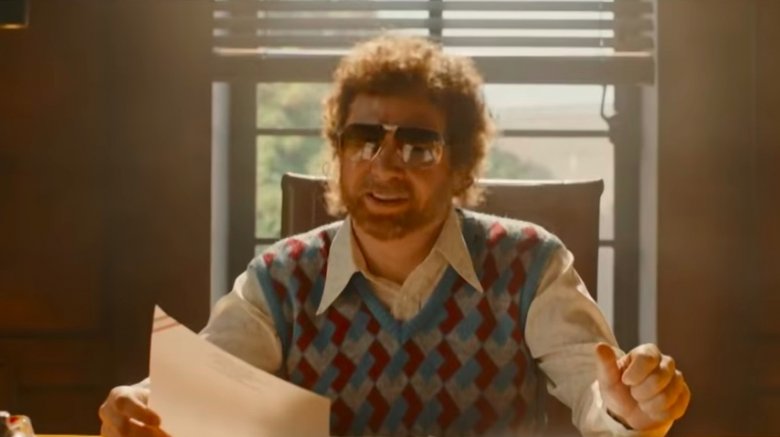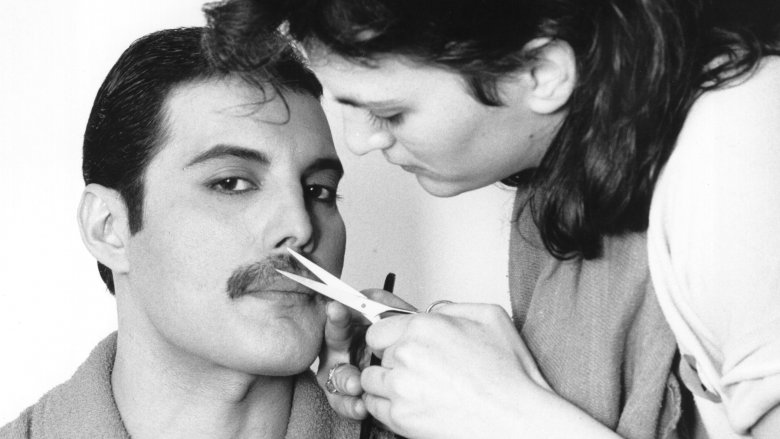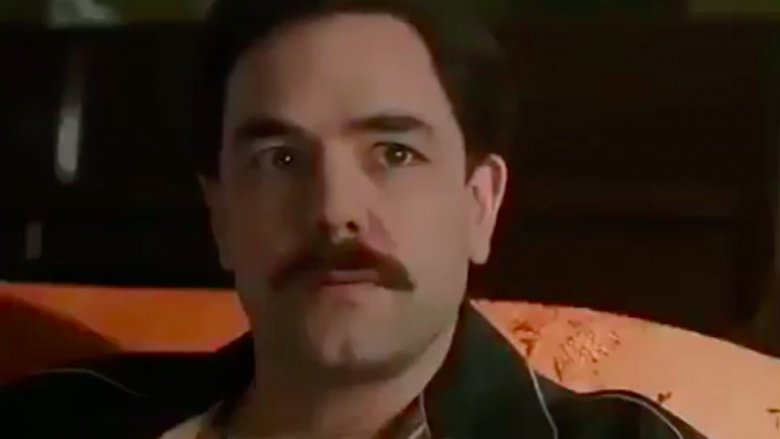11 Times The Bohemian Rhapsody Movie Lied To You
The trouble with real life is that it's mostly super boring. So when Hollywood makes a movie about real life, it kind of has to embellish, move things around, make up characters, and tell lies. When the real life in question is Freddie Mercury's, though, it's harder to justify those decisions. Freddie Mercury's life was not boring. He was brilliant, flamboyant, and one of the greatest voice talents of the 20th century. Also, he was a rock star. You'd kind of have make up stuff in order to make his life seem NOT interesting.
Still, when Bohemian Rhapsody finally made it to theaters, some fans were bewildered by the historical inaccuracies and timeline liberties filmmakers appeared to have taken with the iconic singer's life. Maybe it made for better storytelling, or maybe it was just sensationalism, or maybe the writers were just trying to sanitize and sterilize for a PG-13 audience. We don't know the real answer, but we do know that Bohemian Rhapsody did tell a few lies. (Except for all the stuff about his cats. That was all totally true.)
Getting the band together
In reality, Queen had a much slower evolution than the one portrayed in the film. Mercury already knew Brian May and Roger Taylor — he'd been introduced to them by Tim Staffell, who was the bass player in the pre-Freddie version of Queen, the band called Smile. But at the time, Mercury was singing with other groups, notably a band called Ibex, which later changed its name to Wreckage. According to Queen Vault, the first time Queen members were on stage together was actually at an Ibex show in 1969, when Brian May and Roger Taylor joined Mercury (who was still using the name "Bulsara") on stage for an encore. By the time Staffell decided to quit Smile, May, Taylor and Bulsara (Mercury) were sharing an apartment, so they were hardly strangers.
So there was no shy approach at the end of a Smile show and no impromptu audition. It is true that Staffell's departure gave Mercury the in he needed to join the group, but he was already a part of May and Taylor's musical circle and had been for some time.
The marriage proposal
The relationship between Freddie Mercury and his long-time girlfriend Mary Austin probably came as a surprise to viewers who were more familiar with Mercury's reputation as a gay man living the rock star lifestyle. But a lot of what the film says about his relationship with Austin is true. He did spend many years in a heterosexual relationship, and the two of them were actually engaged to be married.
But the proposal didn't go down exactly like it was depicted on the big screen, and the ring wasn't the big, gaudy diamond we see in the film, either. In a 2013 interview, Austin described the proposal as a lot more light-hearted than it was in the movie. "He gave me a big box on Christmas Day," she said. "Inside was another box, then another and so it went on. It was like one of his playful games. Eventually, I found a lovely jade ring inside the last small box. ... I was shocked. It just so wasn't what I was expecting. I just whispered, 'Yes. I will.'"
Freddie and Mary's estrangement was awkward and lengthy
Freddie Mercury and Mary Austin never did get married, and on that point the film gets a lot of things right. Mercury started cheating on Austin with men, and his confession went down pretty much like the film said it did — he told her he was bisexual, and she replied, "No, Freddie, you're gay."
But that's where the accuracy ends. The truth is there wasn't a lot of awkwardness at the end of their engagement, and there was no lengthy separation, either. According to Biography, Austin kind of just transitioned from ex-fiance to dear friend and a part of his entourage, and the two remained close until Mercury's death in 1991. In the film, their relationship was depicted as much more strained — and much more separate — after their breakup, and that's just not the way it was. In fact Mercury continued to think of Austin as his "wife," and was once quoted as saying, "All my lovers asked me why they couldn't replace Mary, but it's simply impossible. The only friend I've got is Mary, and I don't want anybody else. To me, she was my common-law wife. To me, it was a marriage."
Ray Foster rejected Bohemian Rhapsody and got a rock through his window as thanks
One of the more entertaining scenes in the film is the meeting between Queen and Ray Foster, the fuzzy-haired, sunglasses-wearing EMI executive who is too short-sighted to see that "Bohemian Rhapsody" is a masterpiece. Foster is played by Mike Meyers, and the whole scene is really just a nod to the famous moment in the Wayne's World movie, in which Meyers and his head-banging buddies are rocking out in a car to the legendary anthem. In the biopic, Foster complains that "Bohemian Rhapsody" is "six bloody minutes" and that they should choose "I'm in Love with my Car," as the band's next single instead. "That's the kind of song teenagers can crank up the volume in their car and bang their heads to," he declares. "'Bohemian Rhapsody' will never be that song."
It's a funny moment — even more so if you're a Wayne's World fan — and it should be pretty obvious that it never actually happened. But not only that, Ray Foster wasn't even a real person. According to Rolling Stone, he's loosely based on EMI chief Roy Featherstone, who did think "Bohemian Rhapsody" was too long to be a single. But the rest of the scene — and the character — are pure fiction.
Freddie Mercury fired John Reid in the back of a limo
We the audience are just starting to figure out how much we should hate Paul Prenter in that moment where Queen's manager John Reid gently suggests that Freddie Mercury should consider making a solo album. Prenter (who in a previous scene insists that the solo album thing will go down better if it comes from Reid) explicitly denies having anything to do with the idea, and so Mercury boots Reid out of the limo.
According to Ultimate Classic Rock, it didn't happen like that at all. In fact Reid's departure was rather anticlimactic, and went something like, "I'm leaving," "Okay, cool." Reid left Queen in 1977, and the band still remembers their relationship pretty fondly: "We had a good working relationship with John," Taylor said in the 2011 Queen documentary Days of our Lives. "He was very fiery and very feisty, but so were we. So we weren't scared of him."
Freddie Mercury quit Queen to go solo
Every film has to have a low point, when the protagonist makes the wrong choice, and bad things start to happen. In Bohemian Rhapsody, that moment comes when Mercury tells his bandmates that he's tired of it all, and he wants to leave the band to work on a solo project. His bandmates are devastated and betrayed, and they all part on very bad terms, with Taylor spitting out the uber-dramatic accusation, "You just killed Queen."
Again, that's not exactly what happened. According to Ultimate Classic Rock, the band did indeed take a break after the 1982 release of their album Hot Space, but it wasn't a "break up," specifically, and everyone was pretty much on board with the idea. Mercury wasn't the only one working on a solo project at the time, either — May was already working on a solo record called Star Fleet Project, and Taylor was getting ready for a solo album of his own. And their time apart was hardly isolating. In the Mercury biography A Kind of Magic, Taylor said he didn't think Mercury even wanted to be doing a solo album. "It's just that he got an awful lot of money from CBS. When it came down to actually doing a solo album, he did sort of miss us. He used to ring me up, and I'd have to fly to Munich to do his background vocals."
Big, bad Prenter
Every film needs a villain, and in Bohemian Rhapsody it's Paul Prenter, Freddie Mercury's one-time manager and man-with-evil-intentions. In the movie, Prenter is depicted as controlling and selfish, failing to pass along Mercury's messages and running pretty much every aspect of the singer's life while friends fade away and opportunities pass by. After Mercury wises up and fires him, Prenter goes public — telling the media all of Mercury's secrets in a television interview. But how much of a bad guy was Paul Prenter, really?
It is certainly true that the other members of Queen hated him, in fact according to Metro, May and Taylor didn't like the sound of Hot Space after it was released, and they blamed Paul Prenter's influence. And it is also true that the dude was a jerk, but the details in the film are all off. The timing of his firing is wrong, for example — he was actually still working for Mercury during Live Aid, and he didn't go public after he was fired, but before (and it was in print, not on television). Mercury terminated Prenter's employment after he sold a story to the Sun that ran with the scandalous headline "AIDS Kills Freddie's Two Lovers." So the dirt-selling was actually the reason for the firing, not the result of it.
The long delay before Live Aid was because of the band's break-up
Unlike in the film, real-life Queen never actually broke up, so this detail can't be true already. It actually seems to have been invented to forward the idea that Mercury, with his recent AIDS diagnosis, was eager to reconcile with his musical family and get back to his life's purpose of writing songs and making music. The truth is that not only was the band not broken up, they'd just returned from a world tour two months earlier.
According to Slate, the real reason for the band's late entry into Live Aid was because Bob Geldof, the show's organizer, wasn't sure he wanted them there. At the time they were kind of being collectively shunned by the rock and roll community for a series of strange touring decisions — first a concert in Argentina, which was under the rule of a corrupt and murderous dictatorship, then in apartheid South Africa. Then, when the Live Aid invitation finally did come, the band hesitated. But it wasn't because Paul Prenter failed to pass along the message, it was because they didn't like playing in daylight, and they weren't sure the sound at the event would be up to their standards. Fortunately for rock and roll history (and the film) Queen finally agreed, and turned out what is widely believed to be one of the greatest musical performances of all time.
Freddie's diagnosis came just before Live Aid
In what is probably the biggest liberty that movie makers took with the Freddie Mercury story, we see Mercury's health start to deteriorate as he's working on his solo album, not long before the epic Live Aid performance that culminates the movie. Just before Live Aid, Mercury tells his band mates that he has AIDS, and they rally around him in support. But according to Ultimate Classic Rock, the film got the dates all wrong — by most accounts, Mercury wasn't diagnosed until 1987, two years after Live Aid.
Of all the film's fictions, critics have probably been most up in arms about this one, writing that it was an insult to Mercury to suggest that having AIDS somehow had something to do with his epic performance at Live Aid. But it's hard to know what critics would have said if the film had taken the opposite approach by just ignoring the AIDS diagnosis altogether. It's clear, though, that filmmakers did not want Bohemian Rhapsody to be the tragic story of a man in decline, but rather the uplifting story of a man who became a superstar. They couldn't ignore the tragic circumstances of his death, either — hence the AIDS diagnosis time-shuffle side by side with Freddie Mercury's finest onstage accomplishment.
Jim Hutton worked for Freddie Mercury as waitstaff
Freddie Mercury's longtime partner Jim Hutton was indeed a strong positive influence in the last years of his life, but the way they met was nothing like it was depicted in the movie. In the movie, Hutton is working as waitstaff for Freddie Mercury, and Mercury hits on him while Hutton is cleaning up after a huge party at the singer's home. The two share some deep conversation, then Hutton walks off, leaving Mercury to scour the phone directory in hopes of finding him again. The real life details are lot more boring and way less romantic.
According to Vanity Fair, the two actually met at a gay nightclub in the mid-1980s, when Hutton was working as a hairdresser. Mercury offered to buy Hutton a drink, but Hutton refused. The two did reconnect a year and a half later, but not using the phone book. It was just at another nightclub. It's one of those embellishments that doesn't make a lot of sense — it's sweet and crazy-stalker-romantic to think that Mercury put that much effort into tracking down a guy he'd once had a single conversation with, but it's also kind of unnecessary. Great love stories don't always have to begin with cheesy romance.
Mary Austin and Jim Hutton formed a bond at Live Aid
There doesn't seem to be any record of whether Jim Hutton and Mary Austin actually stood next to each other backstage at Live Aid as they do in Bohemian Rhapsody, but it seems pretty unlikely. The film shows the pair marveling at Mercury's performance — which is at least partially accurate, since Jim Hutton recalled being "gobsmacked" while watching the show — and even shows them embracing at one point. But the truth is that Mary Austin and Jim Hutton were probably not chummy. In fact after the singer's death, Austin inherited Freddie's house and the bulk of his estate, and then took it upon herself to kick Hutton out of the house, even though Mercury had said he wanted Hutton to stay.
According to journalist Tim Teeman, Hutton was given three months to pack up his stuff and leave, and he then used the £500,000 the singer left him to buy a house in west London and build a second home in Ireland. So he wasn't left in the lurch or anything, but Mary Austin clearly didn't want him to stick around.











